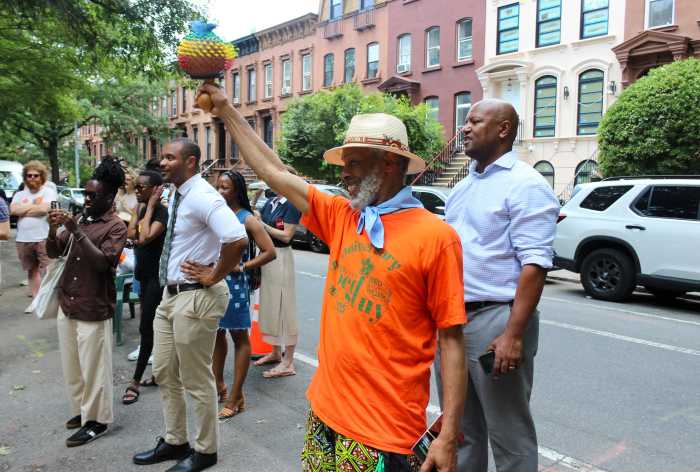Barely a Superfund site a week, and the Gowanus Canal has already vanquished one developer, and is causing problems for another.
Dolly Williams, a former member of the City Planning Commission, told an overflow crowd at a public meeting last week that a potential deal fell through because of the stigma associated with the designation, which will trigger a $500 million federally overseen cleanup of the polluted canal.
“I just lost the sale. It’s because of Superfund,” said Williams, co-founder of A. Williams Construction, a general contracting firm based on Third Avenue.
She said the prospective buyer of a property on Ninth Street read about the designation, and was suddenly “no longer interested.”
Williams said a depressed real market has people already adopting a “wait and see” attitude. But the designation is going to make buyers even more cautious, she warned, making it difficult for people like Williams who, she said, “work and create [to] jump start the economy.”
In 2007, Williams, Brooklyn’s representative on the commission, was not reinstated by Borough President Marty Markowitz after questions were raised in the press about her financial stake in proposals or projects being weighedby the City Planning — including the rezoning of the Gowanus and the Atlantic Yards project. Asked if she supported the designation from the perspective of a former City Planning commissioner and not a developer, and Williams said she did. “Ultimately, yes. This canal has to be cleaned up, and I am glad this is happening.”
Last week, Toll Brothers said it would not be going forward with a residential development it planned along the Gowanus. “At this moment we see no possibility of doing a project on the canal,”said David Von Spreckelsen, a senior vice president with the national homebuilder.
But at the March 4 meeting, held inside Public School 58 in Carroll Gardens, EPA officials again insisted that a clean canal will only enhance the area, making it eventually more attractive to development.
The agency announced its intention to designate the canal on March 2, and in so doing eschewed a developer-friendly alternative plan by the city, which backers said would do the same job as the feds, but without the stigma.
The agency said its work is already underway, and would span the next 10-12 years, or until the waterway is cleaned. The agency will soon be gathering air and sediment samples in and around the canal, and complete a risk assessment report.By 2011, the EPA said it will craft a feasibility study, presenting the array of problems along with the agency’s proposed solutions, and by 2012, a remedy should be announced, and two years later, a plan will be designed.The construction, or actual cleanup phase, which will likely entail dredging the canal and removing decades of toxic muck interred in its sediment, will span about 5 years.
Walter Mugdan, EPA’s regional Superfund director, said the agency’s goal was to clean up the waterway, but also to ensure that parcels surrounding the canal don’t continue to pollute it. The EPA, he said would be working closely with the state Department of Environmental Conservation, which is overseeing the cleanup of the Whole Foods site at Third Avenue and Third Street, as well as Gowanus Green a massive, contaminated, and vacant site abutting the canal where a mixed use development is expected to some day rise.
“Our task is to make sure that those parcels that continue to dribble [toxins] in the canal — that has to stop,” Mugdan said.
The Superfund program compels those found to be responsible for polluting a site to pay for the cleanup.
The city, along with companies like Consolidated Edison, National Grid and troubled specialty chemicals maker Chemtura all received letters from the EPA’s Region 2 Emergency and Remedial Response Division, alerting them that they are potentially responsible for paying for the cleanup.
And as this paper reported back in November, the EPA has also sent letters seeking additional data from a range of companies, inquiring about their past practices along the canal. These so-called information request only letters have gone out to local businesses like Bayside Fuel Oil Corporation, but also energy giants such as Chevron, ConocoPhillips Co., and Exxon Mobil, as well as seemingly disparate companies like Citigroup, Kraft Foods, and Honeywell International.
The entities ultimately held responsible for paying for the cleanup will all share one trait in common: ownership of the liability of a company or entity that at one time polluted the canal.
So while National Grid has no active plant along the Gowanus, it owns the liability of KeySpan Energy, which bought out and therefore owned the liability of Brooklyn Union Gas, whose manufactured gas plants helped illuminate the Industrial Revolution — but also leeched hazardous coal tars and other substances into the 1.8-mile long waterway.
“Citigroup must have polluted the canal, I guess, with toxic mortgages,” deadpanned City Councilmember Brad Lander.
The EPA said it could not detail a company’s liability until the information requests are fully answered, likely in the next few months.
But Mugdan said many of the companies where additional data was requested have been involved in other Superfund sites. “If we conclude they are responsible parties, we expect and anticipate they will step forward cooperatively,” he reasoned.
In sections along the canal where there is no responsible party to be found, the EPA itself will pay for the work out of money appropriated to the Superfund program.






















